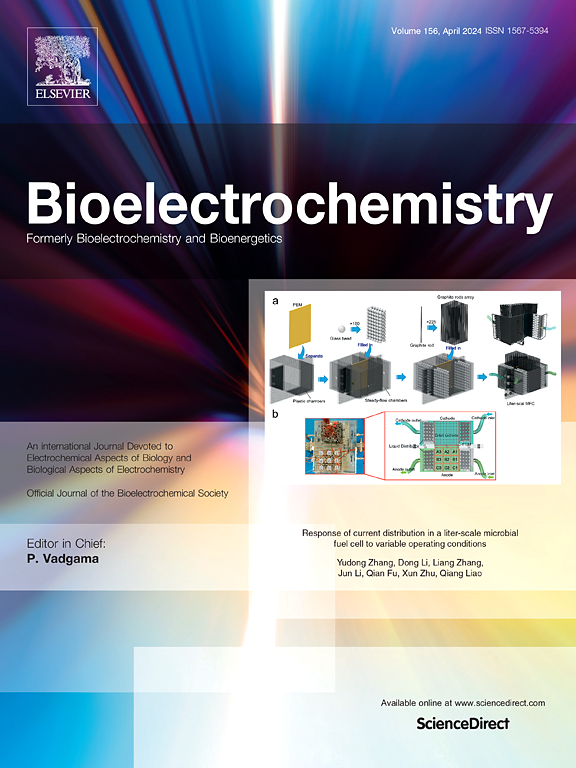基于CdS量子点调制hfs - cu2 +-g-C₃N₄超灵敏检测Aβ的电化学发光/比色生物传感器
IF 4.8
2区 化学
Q1 BIOCHEMISTRY & MOLECULAR BIOLOGY
引用次数: 0
摘要
在这项工作中,我们提出了一种基于氢键有机框架(HOFs)-Cu2+-石墨氮化碳(g-C3N4)纳米复合材料的电化学发光(ECL)/比色生物传感器,用于超灵敏检测β-淀粉样肽(Aβ)。hhofs - cu2 +-g-C3N4既可以作为ECL发光底物,也可以作为纳米酶催化3,3 ',5,5 ' -四甲基联苯胺(TMB)的显色反应。具体来说,在ECL模式下,HOFs-Cu2+-g-C3N4首先被加载到电极表面。目标分析物Aβ可以同时结合Cu2+和肽片段KLVFF,从而捕获电极上的CdS量子点(QDs)-KLVFF。CdS量子点可以与hfs - cu2 +-g-C3N4进行ECL共振能量转移,导致ECL强度增加。同时,在比色模式下,负载在磁珠上的适体可以特异性捕获目标Aβ。hfs - cu2 +-g-C3N4作为纳米酶在TMB-H2O2显色系统中可以与目标Aβ顺序结合。利用功能化磁珠进行磁分离,实现了Aβ的简便比色检测。ECL法检测a β的浓度范围为0.1 pM ~ 0.1 μM,检出限为0.07 pM;比色法检测a β的浓度范围为0.1 pM ~ 0.1 μM,检出限为0.032 pM。这两种不同的检测模式提高了Aβ检测的灵敏度和可靠性,在阿尔茨海默病的早期诊断中具有潜在的适用性。本文章由计算机程序翻译,如有差异,请以英文原文为准。
Electrochemiluminescent/colorimetric biosensors for ultrasensitive detection of Aβ based on CdS quantum dot-modulated HOFs-Cu2+-g-C₃N₄
In this work, we presented an electrochemiluminescent (ECL)/colorimetric biosensors for ultrasensitive detection of β-amyloid peptide (Aβ) based on hydrogen-bonded organic framework (HOFs)-Cu2+-graphitic carbon nitride (g-C3N4) nanocomposites. HOFs-Cu2+-g-C3N4 could be used both as an ECL luminescent substrate and as a nanozyme to catalyze the chromogenic reaction of 3,3′,5,5′-tetramethylbenzidine (TMB). Specifically, in the ECL mode, HOFs-Cu2+-g-C3N4 were firstly loaded on the surface of the electrode. The target analyte Aβ could simultaneously bind both Cu2+ and the peptide fragment KLVFF, thereby capturing the CdS quantum dots (QDs)-KLVFF on the electrode. The CdS QDs could perform ECL resonance energy transfer with HOFs-Cu2+-g-C3N4, resulting the increase in the ECL intensity. Meanwhile, in the colorimetric mode, the aptamer loaded on the magnetic beads could specifically capture the target Aβ. HOFs-Cu2+-g-C3N4 used as the nanozyme in the TMB-H2O2 chromogenic system could be sequentially bound with the target Aβ. The convenient colorimetric detection of Aβ was achieved after magnetically separating using the functionalized magnetic beads. The concentration range of Aβ detected by ECL mode was 0.1 pM ∼ 0.1 μM with a detection limit of 0.07 pM, while the concentration range of Aβ detected by colorimetric assay was 0.1 pM ∼ 0.1 μM with a detection limit of 0.032 pM. These two different assay modes enhanced the sensitivity and reliability of the detection of Aβ and demonstrated potential applicability in the early diagnosis of Alzheimer's disease.
求助全文
通过发布文献求助,成功后即可免费获取论文全文。
去求助
来源期刊

Bioelectrochemistry
生物-电化学
CiteScore
9.10
自引率
6.00%
发文量
238
审稿时长
38 days
期刊介绍:
An International Journal Devoted to Electrochemical Aspects of Biology and Biological Aspects of Electrochemistry
Bioelectrochemistry is an international journal devoted to electrochemical principles in biology and biological aspects of electrochemistry. It publishes experimental and theoretical papers dealing with the electrochemical aspects of:
• Electrified interfaces (electric double layers, adsorption, electron transfer, protein electrochemistry, basic principles of biosensors, biosensor interfaces and bio-nanosensor design and construction.
• Electric and magnetic field effects (field-dependent processes, field interactions with molecules, intramolecular field effects, sensory systems for electric and magnetic fields, molecular and cellular mechanisms)
• Bioenergetics and signal transduction (energy conversion, photosynthetic and visual membranes)
• Biomembranes and model membranes (thermodynamics and mechanics, membrane transport, electroporation, fusion and insertion)
• Electrochemical applications in medicine and biotechnology (drug delivery and gene transfer to cells and tissues, iontophoresis, skin electroporation, injury and repair).
• Organization and use of arrays in-vitro and in-vivo, including as part of feedback control.
• Electrochemical interrogation of biofilms as generated by microorganisms and tissue reaction associated with medical implants.
 求助内容:
求助内容: 应助结果提醒方式:
应助结果提醒方式:


